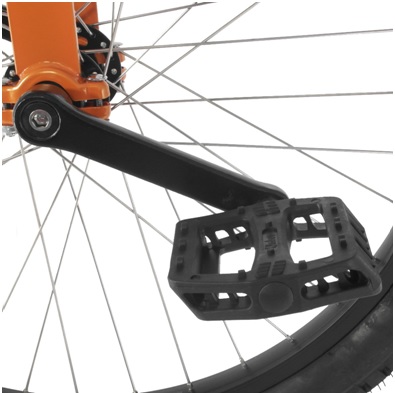Which Schwinn Retro Unicycle Is Right for You?
04/01/22
Without a doubt, two of the coolest unicycles we offer on our website are our Schwinn retro unicycles. Schwinn Bicycle Company, which is noteworthy not only for its longevity but for contributions to cycling as a sport and a hobby in the form of the Schwinn Corvette, Sting-Ray, and others, also made unicycles.
Fans of Schwinn will love our retro one-wheelers which are a throwback to Schwinn’s Chicago days, with a few features updated for modern convenience. Can’t decide which one to get? This short guide should help you choose!
What Both Schwinn Unicycles Offer
Both of our Schwinn Uncycle’s feature a show stopping orange steel frame that’s made the way they were when the company was in Chicago. Both of them feature a two-piece round-crown steel mainframe attractively embellished with the Schwinn logo on the fork.
They both come with a Schwinn saddle with a front lift handle and bumper, as well as a 22.2mm x 350mm steel seat post with a welded rectangular 4-hole mounting bracket. The seat post can be cut down and these unicycles both come with a Schwinn steel binder bolt seat post clamp.

The frames of both models have 40mm stamped main cap bearings and hub axles with CrMo spindles with 100mm center-to-center bearings.
Though they have different tire sizes, they both take 2.1” tubes and 2.125” tires. They also both have 37mm singlewall aluminum rims which offer a decent balance of high strength and lightweight.
They both accept cotterless steel crank arms (the 20 inch comes with 114mm crank arms and the 24 with 140mm) and they both come with black Nimbus pedals. The smaller version is slightly lighter, tipping the scales at 12 lbs, and the larger version comes in at 15.
That just about covers the technical specifications of both of these Schwinn retro unicycles, but doesn’t answer any questions about which one you should get.
Well, the most straightforward approach we can take has to do with rider height and measurements. The 20 inch Schwinn is best for riders with a minimum inseam of 28 inches, and the 24-inch model is recommended for riders with a minimum inseam of 33”.
But that’s just one way of looking at it. We can also talk about discipline.
Go with the 20 Inch Schwinn Retro Unicycle…
Both 20 and 24-inch unicycles can make good beginner one-wheelers (depending on inseam measurements) but agility and handling are really where smaller models, like a 20” unicycle, really take the cake.
The shorter crank arms and smaller wheel diameter give smaller unicycles like this one greater overall maneuverability. They’re great for making quick turns and abrupt movements. Unicycles with 20” wheels are also great for unicycle sports like basketball or hockey.
It’s also easier to start and stop a unicycle with a smaller wheel. This is partly because the wheel carries less rotational momentum. This makes these smaller cycles better for riders who like to perform tricks. That being said, this is a cruiser unicycle and should not be used to perform rough tricks, but if you like freestyle riding or nimble handling, it’s probably the one for you.
A small tradeoff comes in the form of versatility. Even though the smaller wheel size is more nimble, it also means this cycle is best suited to riding over flat, even surfaces, such as indoors, so that’s something to keep in mind.
Because of this unique mix of features, 20” unicycles generally make beginner cycles. Though they’re not the best for riding longer distances, they are nimble and can be forgiving, especially on smooth surfaces.
Maybe the 24 Inch Model Is More to Your “Speed”...
Now let’s get onto the larger wheel size. If you’re tall enough to ride it and you want a more versatile beginner Schwinn retro unicycle, this is probably the one for you.
If you can excuse the pun, this might be more to your speed if you’re into, well, speed. The larger wheel size will make it possible for you to attain higher speeds with this unicycle than would be possible, or feasible, with the 20” model.
Not only can you ride faster on a larger cycle, but you can ride faster, more comfortably, for longer. The larger diameter will carry greater rotational momentum (like a flywheel). That means it will be harder to start the unicycle, but harder to stop it as well. As in, once you get the wheel moving at a certain speed, it’s easier to keep it going than it is with a smaller wheel.
Another great thing about the larger wheel size is that it will enable you to ride over (slightly) rougher terrain more comfortably, and comfort counts. Don’t get us wrong, this is no mountain unicycle, but minor bumps and dips are a lot less harsh over a 24” wheel than they are over a 20” wheel.
The best part is that a 24” unicycle is not too big to use for performing basic tricks, even though it’s great as an all-purpose, beginner cruiser unicycle. If you can comfortably ride it and your intention is to commute or ride for longer distances, consider getting the larger of our two Schwinn retro unicycles.
Can’t Decide? Get Both!

Now that the dust has settled and we’ve offered our two cents on the matter, we should state that most serious unicyclists have more than one in their collection. It’s just a plain fact that size and other features make some unicycles more suitable for touring, mountain riding, and freestyle riding. Sometimes you need more than one.
If you’re just the right height that you can ride both a 20” and a 24” unicycle comfortably, why not just get both? Make one a freestyle rider and the other a cruiser. With both in your collection, you’ll be able to ride in style, too. And don’t forget a helmet, knee, elbow, and wrist pads!
For those of you that have questions about any of our unicycles or odd bikes, including our Schwinn retro unicycles, please feel free to contact us. You can reach out to us via the live chat window (at the bottom of this screen) or contact us by phone at 678-494-4962 if you still have questions.

